Regulation of electricians in Scotland: research report
Research conducted by Pye Tait to independently assess the evidence and build a business case to determine if regulation is required.
3. The Evidence
This section presents information gathered from existing reports and other research as well as that which we received as a result of the Call for Evidence (see Methodology). This exercise helped add to the overall picture of the type and quality of available evidence, our assessment of which is discussed in section 5.
The initial phase of the research sought to establish what was already known about defective electrical installations in domestic settings in Scotland and what kind of evidence base had been established thus far (see summation below).
Research by Electrical Safety First gives some useful statistical evidence of the safety hazards of electrical defects in Scotland and the UK. Added to that is some comprehensive research on the topic to date, developed by SELECT whose report "Electrician as a Profession" makes a case for more regulation of the electrician profession through protection of title.
The key facts from these sources and further research undertaken in 2019 are listed below:
SFRS (2016-2018)
75% of fires in Scotland caused by electricity (SFRS 2016)
598 electrical fire casualties and 9 fatalities in Scotland (SFRS 2016)
According to SFRS (2017-2018), 8% of fires in Scotland have electrical causes, but the human factor in such cases is not recorded
SELECT (2016)
93% of Scottish householders associate the term electrician with a set of relevant qualifications
89% of Scottish householders do not know how to check an electrician's qualifications
Case studies show a problem of defective electrical installations
SELECT calls for the title of Electrician to be protected
Further research (2019) noted that:
Citizens Advice Scotland (CAS) kindly provided some case studies but do not indicate a large evidence base of defective electrical installations
Local authority Trading Standards Services have very few cases on record of unsafe installations in domestic setting
Electrical Safety First data do not distinguish between unsafe electrical installation work and faulty white goods nor do they distinguish between faults caused by the decay of old wiring and incompetent installation.
3.1 Fire Statistics
The latest fire statistics for Scotland were presented in late 2018 by the Scottish Fire and Rescue Service (SFRS)[12]. Earlier statistics – for 2016 - from Electrical Safety First (based on data from SFRS) show evidence of the importance of electrical safety for health and property: there were 598 casualties and 9 fatalities in Scotland in 2016. This equates to an average of 11 injuries per week from electrical fires in dwellings.
More detailed SFRS statistics for 2017-18 tell of around 26,000 fires attended in Scotland during that year, resulting in 44 fatalities and 1,113 other injuries. Within this total there were 5,700 dwelling fires, of which around 4,700 were considered accidental (note that some 25% of primary fires are classed as deliberate). These 4,700 accidental dwelling fires break down into different ignition sources as illustrated in Table 2.
Table 2: Ignition Source of Accidental Dwelling Fires in Scotland
| Ignition Source | % (*) | Number of accidental dwelling fires |
|---|---|---|
| Cooking appliances | 62.2 | 2,924 |
| Smoking | 7.7 | 362 |
| Other appliances | 7.4 | 349 |
| Electrical supply | 7.2 | 338 |
| Heating equipment | 4.1 | 193 |
| Electrical lighting | 1.6 | 75 |
(*) These proportions are of the 4,700 accidental fires in Scotland in 2017-18. The percentages do not add up to 100% because "other causes" (around 10%, of the total) have not been listed.
Accidental fires caused by electrical supply and lighting totalled 413 (just under 9% of the total of 4,700). This compares with 3,466 accidental domestic fires caused by appliances in the home.
For further context, there were 9,000 injuries and 146 deaths on Scottish roads in 2017.
3.2 Electricians in Scotland
To provide a baseline of the number of electricians operating in Scotland, data for the Standard Occupation Classification (SOC) code 5421 Electricians and Electrical fitters for the UK has been used against overall population data for the UK and Scotland.
ONS data suggest that, as of June 2018[13], 265,000 people were operating under this SOC code in the UK. This includes both employed and self-employed. To determine an indicative number of electricians operating in Scotland we have used the Scottish population as a proportion of the UK figure (latest data 2017[14]) – 8.2% - as a proxy for Scottish electricians. SOC code 524 shows that there were around 23,400 Electricians in Scotland in 2017. For 2018 we have used an approximate number of electricians and electrical fitters in Scotland as c22,000[15].
3.3 Profile of electrical organisations
In order to develop the scale of numbers that are aligned to trade, registration and certification bodies, and to estimate unaffiliated electricians, a profile of their memberships or registrants has been developed.
For comparison of electricians the SJIB provides the easiest basis as it has individual registrants. SJIB registrants account for 10,195 qualified electricians in Scotland, almost half of the 22,000 estimated total (c46%). In addition, there are an estimated 3,000 apprentices/adult trainees who are also registered with the SJIB, suggesting that up to 60% of those under SOC 5241 could be registered with the SJIB.
The Electrical Contractors Association for Scotland (SELECT) and the National Inspection Council for Electrical Installation Contracting (NICEIC) Scotland have members and registrants respectively that are electrical enterprises/contractors rather than individuals in Scotland.
SELECT has 1,231 member-businesses based in Scotland. NICEIC has 1,062 electrical contractor businesses registered on its schemes. NAPIT currently have 133 registered members in Scotland, 40 of which are registered solely as electrical contractors, with 93 electrical contractors undertaking Microgeneration Certification Scheme (MCS) solar voltaic installations. Additionally, NAPIT has 336 registered electrical contractors within 30 miles of the Scotland who are likely to operate on both sides of the border.
Membership requirements for these organisations differ and a selection of those are: - specific qualifications for individual SJIB registrants, having personnel who meet National Occupational Standards is a stipulation for SELECT membership[16]. Registration with organisations like NICEIC includes independent, onsite assessment of the technical competence of the qualified supervisor(s).
- However, there is a lack of awareness among homeowners of the existence of these organisations with a recent YouGov survey (2017) identifying that 88% had never heard of SELECT and 87% had never heard of NICEIC.[17]
3.4 "Electrician as a Profession"
In 2016, SELECT commissioned a major consumer survey from the market-research firm TNS (Kantar-TNS). For that extensive survey, over 1,000 home-based interviews were carried out, with adults in Scotland, over a one-month period (June of that year). The sample was structured to be representative in geographic and demographic terms (age, gender and socio-economic group were subsequently weighted to ensure representativeness against the Scottish Mid-Year Census results)[18]. The survey only addressed people's use of electricians and their attitude towards some form of registration and revealed some extremely interesting statistics.
- Some 93% of Scottish householders associate the term "electrician" with a set of qualifications. 89% of this group are not aware of how these qualifications can be checked and verified.
The evidence of a lack of awareness of qualifications is complemented in the report with a series of case-studies, provided by electrician-members of SELECT, of defective electrical installations. These were used to illustrate the inherent dangers of electrical defects and provide examples of poor practice.
- Electricians cited in the report describe electrical incidents or defective electrical installations in 15 cases with a brief description of the incident. They include images taken from completed Electrical Installation Condition Reports (EICR) that highlight safety hazards from such incompetent installation as reversed polarity, missing sockets and ducting, failure to earth a lighting installation, use of under-sized cable, and more.
The report does not cite any evidence provided by the general public or Scottish householders.
- Six case studies suggest that the work was carried out by workers having no electrical qualifications, such as plumbers and bathroom fitters doing electrical work, together with other examples of generally poor workmanship of electrical installations, equally supported by pictures[19]. In most cases the case studies in SELECT's 2016 report give no indication of the date of the fault or problem.
While the survey focused on the domestic sector, it is not clear if all the cases and case studies of defective electrical installation provided by electricians can be classed as "domestic" (two, for example, concerned a caravan park).
In addition, while the fifteen cases illustrate very well the existence and possible dangers of faulty installation, they do not (in most of the case studies) establish a clear link between a lack of electrical qualifications and poor-quality work leading to safety hazards.
Nevertheless, the six detailed case studies (from electricians) provide some evidence of electrical work being carried by non-trade-related people such as plumbers and employees of a kitchen installation firm, and bad practices, such as the failure to install residual current devices (RCD) as safeguards for socket outlets as per the Wiring Regulations (BS 7671)[20]. The report argues that work carried out by unqualified electricians undermines prices for electrical work of the necessary quality and thereby inherently increases safety risks.
Thus, the SELECT case for regulation is based on two parallel pieces of evidence. The first is the lack of public awareness as to how to check an electrician's qualifications, and the public's association of the title "electrician" with a set of relevant qualifications. The second is the evidence of danger related to defective electrical installations provided by previous research such as that by Electrical Safety First and the cases with case studies.
Combining both bodies of evidence, the report calls for the protection of the title "electrician" as a first step. In practice, this would add Electricians to the list of Regulated Professions in the UK and associate the title with a prescribed set of qualifications. The inherent benefits, the report argues, would be the protection of Scottish householders, the general public, and other electricians, the outlawing of what the report calls "rogue" traders (presumably unqualified), and regulatory coherence.
3.5 Additional evidence
In order to bolster the existing evidence-base we also sought to acquire data from a range of other sources. Efforts to gain further evidence from other parties such as Citizens Advice Scotland (CAS) and local media clearly indicated that no-one is keeping a coherent and detailed record of electrical problems, their effects, causes and dangers.
Information on the type of issues presented to the Citizens Advice Bureau network is gathered by Citizens Advice Scotland (CAS). Until April 2019, anyone seeking advice in relation to this subject at the bureaux are directed to the Consumer Helpline (UK coverage) as they are the primary support for this type of issue. A review by CAS staff of the data from the helpline indicated 115 relevant cases over the space of a year (Electrical installation and supplies; Substandard service). The majority of which, however, were not labelled as a complaint against an electrician.
Several case studies also kindly provided by CAS staff provided deeper information but again did not indicate concerns being raised about lack of qualifications, but cite instead such variables as:
- overcharging for work;
- unwillingness by a trader to provide proof of qualifications; and
- complaints concerning such bureaucratic requirements as the need to obtain a certificate of completion from the local Building Standards authority.
Similarly, local media do not report domestic incidents unless a large-scale event occurs. Even then, clear causes and correlation to work by unqualified workers cannot be necessarily proven.
We found almost no evidence in the Scottish media[21] and enquiries with SCOTSS (the local authority Trading Standards heads of service body) and examination of Electrical Safety First records threw little more light on the issue. Trading Standards receive enquiries in the main through the Consumer Helpline but only where there is a breach of relevant legislation, which may not be the case for domestic installations. SCOTSS noted that there is little evidence of unsafe domestic installations being brought to the attention of local authority trading standards services.
A few examples were mentioned of which two are quoted below as examples of the sort of issues being raised.
- One included a January 2019 case of a faulty installation of a kitchen which allegedly left numerous electrical defects such as electrical wiring being exposed. A failure to change the circuit board may have added to the electrical issue, but this case study did not provide explicit evidence of the qualification status of the electrician(s) who performed the work.
- In another case, a defective electrical installation carried out by a company in 2017, posed a serious fire hazard. The installation had to be rectified by another trader and the original company was taken to court by the consumer with the court deciding in the consumer's favour. This example illustrates electrical safety hazards and poor workmanship/ incompetence in a domestic setting but with, again, no indication of the qualification status of the people undertaking the work.[22]
This feedback suggests that this type of incident is not a regular occurrence and does not provide evidence of a large-scale hazard for the general public.
Similarly, the records of Electrical Safety First could not determine which events took place in Scotland as geographic data were not collected. ESF data were also not segmented according to type of incident: i.e. due to workmanship or failure of appliances/white goods and whether the perpetrators were qualified or unqualified. In summary, the sources listed above even from such a small or limited sample there is no clear evidence to show that a substandard and, therefore, dangerous electrical installation was carried out by unqualified people.
3.6 The Call for Evidence (2019)
In this section of the report four key questions have been addressed:
- What is the potential scale of defective electrical installations in domestic settings in Scotland?
- What type of work is being defectively installed?
- Are certain regions of Scotland more susceptible to defective installations?
- How much are defective installations costing customers?
The Call for Evidence generated 537 responses from stakeholders (88), the public (38) and electricians (411 or 76.5% of the total responses). See Figure 1 (page 15).
In our primary research, 319 electricians confirmed being a current member of a trade body, certification body or registration scheme. Almost three quarters (73%) were members of SELECT (Figure 2). Some electricians are SJIB registered and work in an organisation that is either or both SELECT and NICEIC affiliated.
Figure 2 Respondent memberships[23] (Electricians)

Base: 319 Electricians Pye Tait Call for Evidence 2019: NB: duplicate memberships are possible within these figures.
3.6.1 Sourcing Electricians
Part of the work on this study was aimed at gaining a deeper understanding of how domestic consumers source electricians for their work.
The apparent lack of awareness of the trade and registration organisations means that most customers are likely to use different avenues to look for electricians and this was verified by the survey. Qualitative feedback, corroborated by desk research[24], shows that a recommendation from family or friends is the most common source of an electrician (58%). Sometimes this can be family and friends who are electricians themselves (24%). Over a third of respondents use the same person they have always used (36%).
One member of the public who responded to our survey and had used the same electrician for multiple jobs, but went on to say that this approach allowed for defective work to go unnoticed for some time as the electrician did not identify their own work as defective.
We used the electrician on a recommendation from our son in law, who was working with him at the time. He [the electrician] had done work [on our properties] previously that also turned out to be faulty.
Member of the public
This respondent (albeit a lone case) said that it was only by getting an NICEIC-approved electrical contractor to check the work that the extent of the issues and the need for this work to be rectified were spotted.
Many of the public respondents said that they were unaware of, or could not remember, the method used to source an electrician. Of the 22 respondents – across all types - who could remember, taking advice from family and friends was where almost a third (7) got their information. Over a quarter (6) had to rely on a landlord decision but 4 took advice from a trade body such as SELECT (Figure 3).
Figure 3: Sourcing the electrician who installed the defective work.
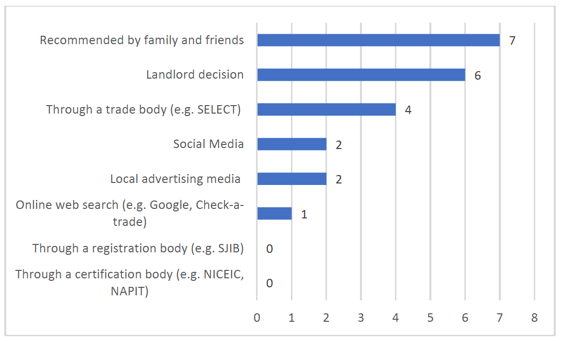
Base: 22 respondents; Pye Tait Call for Evidence 2019
In almost half of all those cases responding to this question (including the Don't Knows, Others etc), those hiring the electricians were unaware of any memberships they may have held and almost three quarters did not check for themselves the validity of the information if told that the electrician was a member of an association or trade body.
Of those total respondents to this question (57), 19 were able to identify from which trade or registration body the electrician completing the defective job claimed membership. The majority of the 19 were apparently members of SELECT (12), plus 2 SJIB and 5 NICEIC. The overall results are illustrated in Figure 4 below.
Figure 4: Trade, certification or registration bodies of those conducting faulty work
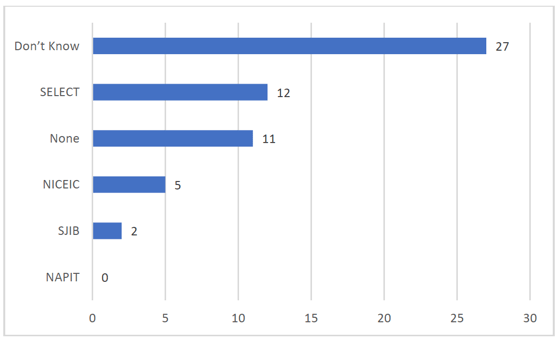
Base: 57 respondents Pye Tait Call for Evidence 2019
A lack of awareness among customers around the regulation of electricians may conceivably have led to defective work being carried out. But, that said, the extensive publicity and awareness campaigns put in place for this Call for Evidence (Appendix 1) attracted only 38 members of the Scottish public to respond and only 12 members of the public provided evidence of defective installations in domestic settings in Scotland over the past three years.
This might suggest that, at least from a public perception point of view, there is little evidence that a problem exists. Based on the information above there may be even less reason to suppose that it is an issue that is specific to those who are not members of trade, certification or membership bodies.
3.6.2 Qualification Type
Electrician respondents provided a total of 892 qualifications[25] of which apprenticeships were the most common and NVQs (usually specific to England and Wales) the least.
Figure 5. Types of Electrical Qualifications (Electricians)
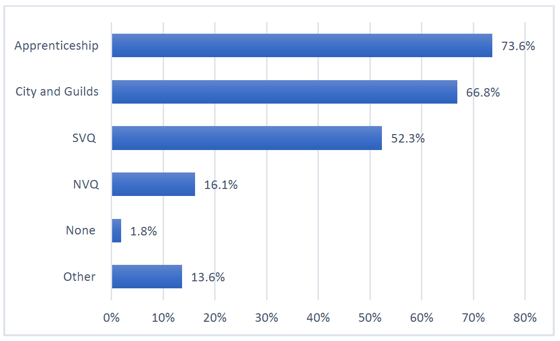
Base: 892 qualifications mentioned in Pye Tait Call for Evidence 2019
In addition, some electricians listed a range of other qualifications such as: Electrical Engineering HNC (12) and HND (2), CompEx (8), Degree level qualification or higher (6 in all, 3 of which are held by one individual who holds a PhD, Masters and BEng degree). Others listed courses run by SELECT (3) or other short courses.
3.6.3 The Scale of the Problem
The majority of electricians (83.4%) responding to the Call for Evidence (411 in all) confirmed that they had been asked to rectify defective electrical installation work in a domestic setting since 2016 – a total of 343 electricians.
Of these, 300 had been asked more than once. On average members of this group recall 30 cases of having rectified defective installations.
Respondents were also asked how long they had been an electrician. The average was just over 24 years, but the most commonly mentioned career-length was thirty years.
The scale of the problem is discussed further in the "Risks" section (4) below.
3.6.4 Regional Distribution
The question of whether there is a regional difference in the distribution of defective installations was addressed in the Call for Evidence in a number of ways. There was no significant difference between the regions as to whether an electrical contractor had ever been asked to fix a defective installation. Well over nine out of ten had been asked to do so across all regions (Table 3).
Table 3: Had an electrician been asked to fix a defective installation
| Scotland | North | Central | South | |
|---|---|---|---|---|
| Yes | 95.40% | 96.10% | 96.40% | 94.10% |
| No | 4.60% | 3.90% | 3.60% | 5.90% |
The average tradesperson in the North of Scotland had fixed 78 installations compared to 87 nationally and over 90 for both the central and southern regions. These figures were somewhat skewed by a few electricians who claimed to have fixed between 500 and 1,000 faulty installations – which is why the most commonly cited figures (the mode) are between 10 and 20. In the case of this question, the mode is probably the most reliable estimate of central tendency. The higher figures for totals of faulty installations (500 and 1,000) are by no means impossible but we used the modal averages in order to ensure that all resulting calculations are conservative.
Table 4: How many times had the individual fixed defective installations (career)
| Scotland | North | Central | South | |
|---|---|---|---|---|
| Mean | 87 | 78 | 95 | 93 |
| Mode | 10 | 10 | 10 | 20 |
| Count | 343 | 96 | 106 | 127 |
The pattern of defective installations by type (as shown in Table 5) across Scottish regions is also identical – with the possibility that there may be a slightly higher proportion of meter issues in the central belt. However, the differences are so small as to be virtually insignificant.
Table 5: Types of Defect by Region
| Scotland | North | Central | South | |
|---|---|---|---|---|
| Electrical wiring | 76.9% | 78.4% | 77.7% | 75.0% |
| Wall sockets | 40.2% | 41.2% | 37.5% | 41.7% |
| RCD/Safety switch | 25.7% | 22.5% | 28.6% | 25.8% |
| Fittings; e.g. lights | 41.0% | 41.2% | 41.1% | 40.9% |
| Meter | 4.9% | 2.9% | 7.1% | 4.5% |
| Other – please specify | 11.0% | 9.8% | 11.6% | 11.4% |
3.6.5 Type of defective electrical installation
The most common type of domestic electrical installation fault is in wiring (77% of all defective work). The electricity meter appears to be the least frequent type of defective installation experienced (5% of all cases).
Electrician respondents and members of the public provided virtually identical proportions for what they believe are the most common electrical installation defects – around 40% concerning electrical wiring, 20% wall sockets, 10% RCDs, 15% fittings and lights, and meters only around 3%.
Figure 6: Types of Defective Electrical Installations
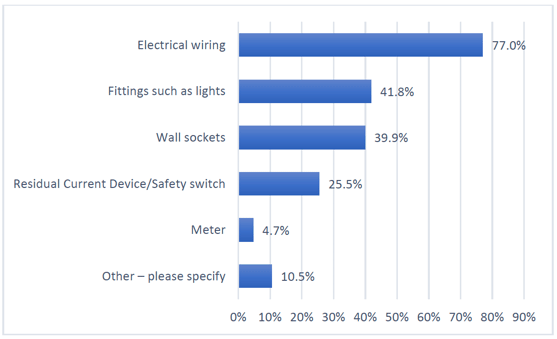
Base: 90 responses from public and 361 from electricians; Pye Tait Call for Evidence 2019
Evidence from the 38 electricians who selected the option "other" (not all gave an example) included the method and quality of installation (3), electric underfloor heating and other heating installations (3), electric shower units or parts thereof (6), of which two examples showed the failure to install RCDs and smoke alarms and detectors (4).
The frequency of wiring as the defective installation also corroborates qualitative feedback which argued that much of the problem is hidden in walls, floors, ceilings and behind fittings.
The quotes below are not meant to indicate the original cause – whether it was an electrical fault, faulty plumbing or some other issue - but make the point that they reflect the information sent to us that the problem is often 'unseen' until something triggers a problem.
I was asked to find the cause of lights that were constantly tripping, after inspection I found that an inadequate installation in the bathroom had caused a build-up of water and had been shorting the cables. This in turn caused the cables to burn up in to the ceiling of the house in to the loft.
Electrician, North Ayrshire
During a domestic installation of kitchen, the fitter wired the lights. Single wires came out of conduit and straight across floor joists they then terminated into an electrical joint box. When the customer walked on the upstairs floor the wires had shorted out and blew the fuse.
Electrician, Dumfries and Galloway
3.6.6 Costs of remedial work
The average cost of the original installation work[26] varies from as little as £100 for work such as installing an additional wall socket, to a rewiring costing between £3,000 and £14,000 (for under floor wiring on a domestic council site). The average cost of work which was later found to be defective (as reported to the Call for Evidence) is £2,700.
The cost of remedial work to fix the defective electrical installation varies from £100 to £4,500 and averages £830.43. The smaller defective installations generally have a bigger mark-up rate due to the call-out cost. For example, a £14,000 project is likely to have salvageable products and some correct installations. Lower level issues can often have the opposite result with £100 for original work then costing £100 to rectify, or even more if there has been additional damage.
In three-fifths of cases, the cost of rectifying the defective installation is paid for by the customer, or their close acquaintances if they are unable to afford the repair, with only 10 being rectified by the original contractor (Figure 7). Only 20 (Figure 8) attempted to contact the original contractor.
Figure 7: How were the repair works paid for?
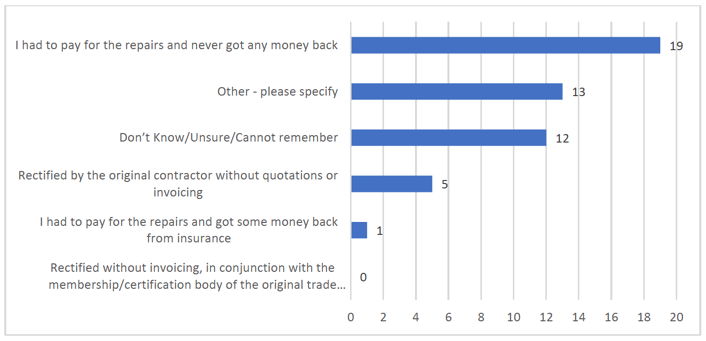
Base: 50 Respondents Pye Tait Call for Evidence 2019
Figure 8: Was the original electrician contacted?
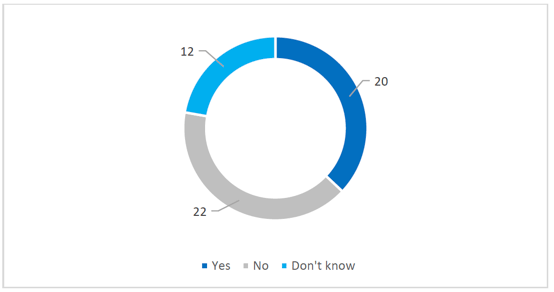
Base: 54 Respondents Pye Tait Call for Evidence 2019
Figure 9: Did the original contractor put the work right?
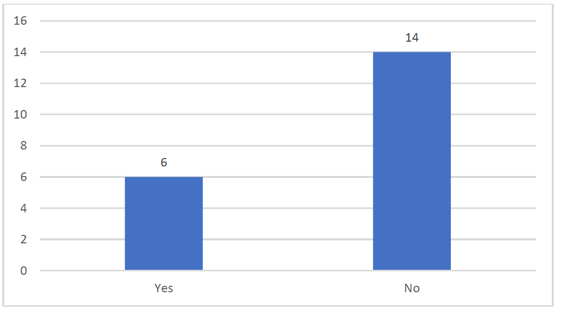
Base: 20 Respondents Pye Tait Call for Evidence 2019
In cases where the original contractor did not rectify the defective installation those who could recall the incident reported turning to another electrician to rectify the defective work. Although the option for completion in the Call for Evidence was provided no-one reported engaging with a solicitor, CAS, Trading Standards or any trade, certification or registration body.
3.6.7 Awareness of the status regarding Electricians
Electricians formed the vast majority of respondents to this research rather than the public/consumers. This was not from want of publicity and effort. We recognise that electricians who take the time to respond to such a Call for Evidence are more likely than others to have experience of defective work and more likely to have strong views on the subject.
This is, perhaps, illustrated by the case of one electrician respondent who, to the question of how many defective installations they had seen in their 25-year career, wrote in 1,000,000 (well over 800 per week for twenty-five years). The answer was obviously a deliberate exaggeration, but it does exemplify the strength of feeling about the subject among some electricians[27].
It would be fair to say, we feel, that the skilled electricians responding to the Call for Evidence came from that section of the occupation which had had more than its fair share of defective installations to repair and, perhaps, more experience of the impacts of low-competence operatives.
As such they might have more cause to be sympathetic to the concept of increasing regulation and to any change which would protect their skilled capabilities from being simulated by lesser-skilled people.
In order to reduce the impact of this bias in the findings we have presented the following results after dividing the respondents into two broad groups: those with experience of defective installations and those without such exposure.
In almost all cases the difference of perception between those two groups is low or negligible.
One interesting finding of this research has been that relatively high proportions of people are unaware of the fact that one does not need a specific qualification or specified training in order to conduct electrical operations[28].
More than four in ten people – whether they have experienced defective installations or not – are not aware of this fact. Notably our findings include the fact that around 40% of electrician respondents to our survey are also not aware that specified education and training are not required to conduct electrical work. The equivalent figure for the general public is 58%. Well over half of the public might believe, therefore, that the title of electrician and a legal requirement for specific qualifications and training are already in place.
Figure 10: Awareness that electricians do not need formal electrical training to practise their trade (with or without experience of defective installations)
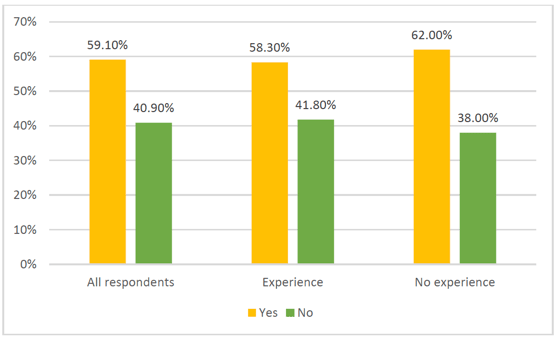
Base: 521 Pye Tait Call for Evidence 2019
The similarity of response rates between those with and without experience of defective installations is also reflected in the vast majority of respondents (89%) who believe that the current regulations are inadequate (Figure 11). More than nine in ten electricians and members of the public who have had experience of defective installations agree with the view that existing regulations are not adequate.
These majorities believing that current regulation is inadequate are repeated when the data are analysed by type of respondent – as in electrician and member of the public – with around 84% of both groups of the opinion that the existing situation is not sufficiently rigorous (Figure 12).
Figure 11: Adequacy of current regulations (by experience/no experience)?
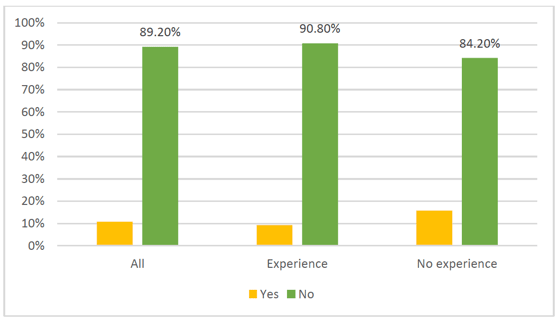
Figure 12: Adequacy of current regulations (by electricians/public)?
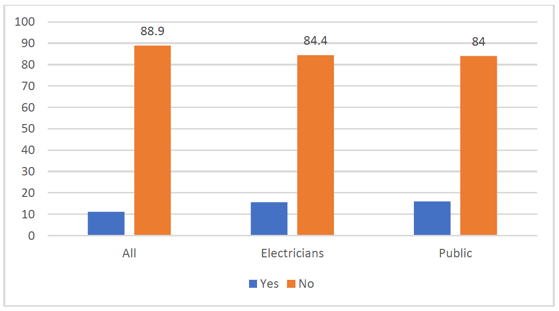
Base: 520 Pye Tait Call for Evidence 2019
The same pattern emerges when looking at whether people believe that the title of "electrician" should be protected by law. Over 90 per cent of both those with experience of defective installations and those without experience believe that the title should be protected. The weight of view between electricians and members of the public is almost exactly the same – over 90 per cent (Figures 13 and 14).
Figure 13: "Electrician" legally protected (Experience/No experience)
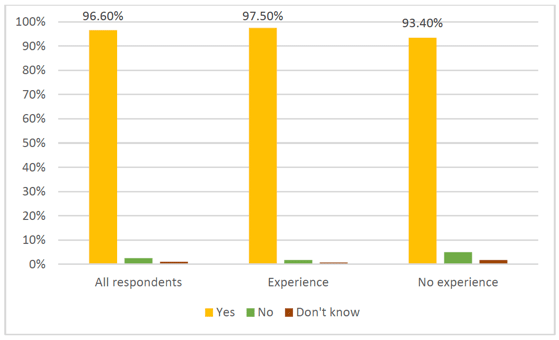
Figure 14: "Electrician" legally protected (Electricians/Public)
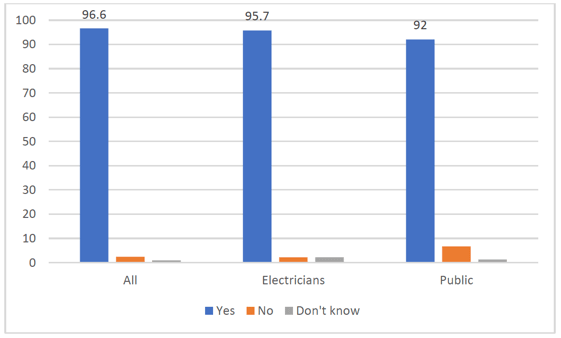
Base: 522 Pye Tait Call for Evidence 2019
Qualitative feedback from our interviewees suggests that regulation and protection is seen as having the potential to reduce the amount of defective installations by both qualified (64% agree) and unqualified electricians (91% agree). There is unanimous agreement, though, that such a situation would require legislative backing (that is, it would not work if made part of any voluntary approach).
A number of interviewees suggested that mirroring the GasSafe[29] register would be a suitable way of practically implementing a protection of title for electricians.
Similar – very strong – results emerged from the question concerning whether electricians should be required to keep up to date and be regularly tested for competence in the same way as GasSafe. As can be seen in Figure 15, very high proportions of both "experienced" groups believe that this should be implemented.
Figure 15: Regular testing of electricians on technical skills and knowledge
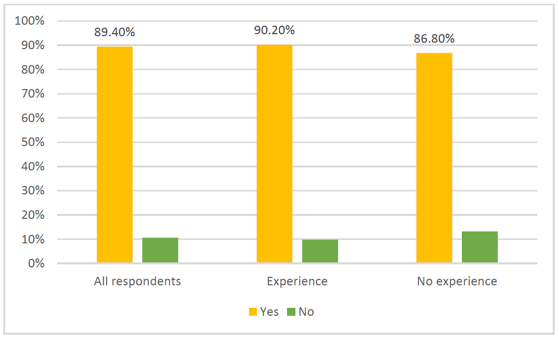
Base: 520 Pye Tait Call for Evidence 2019
High proportions also believe that a full occupational licensing system should be introduced.
Figure 16: Occupational licensing
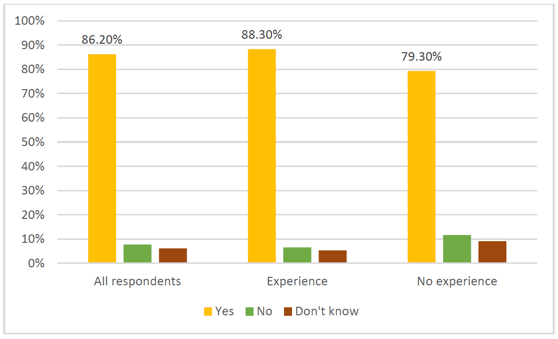
Base: 521 responses Pye Tait Call for Evidence 2019
Licensing of certain occupations is a topic which has been examined in much detail over the past few years with supporters pointing to successful schemes from New York to South Australia, and the legal protection of occupational titles supported by qualification systems in Germany.
Interviewees for this research were generally in favour of licensing. High proportions of them argued that it would reduce the amount of defective installations by both qualified (67% agree) and unqualified electricians (100% agree).
Other recent research by Pye Tait for The Electrotechnical Skills Partnership (TESP)[30] in 2019 found that 66% of a sample of Scotland-based electrical companies would wish to introduce occupational (individual) licensing.
As might be expected, almost two thirds of respondents in the recent Call for Evidence argued that the general public would be the greatest beneficiary of any system of occupational licensing but a third felt that electricians and the industry would also benefit (Figure 17).
Figure 17: Beneficiaries of a system of occupational licensing
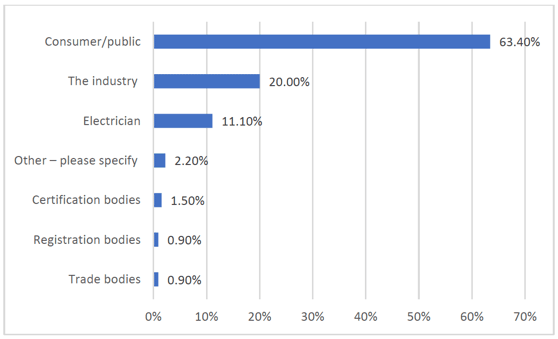
Base: 521 responses Pye Tait Call for Evidence 2019
When asked to consider other alternatives approaches to resolve the problem of defective installations most suggested that raising awareness and educating the public was an important need to reduce the problem in domestic settings across Scotland.
Contact
There is a problem
Thanks for your feedback